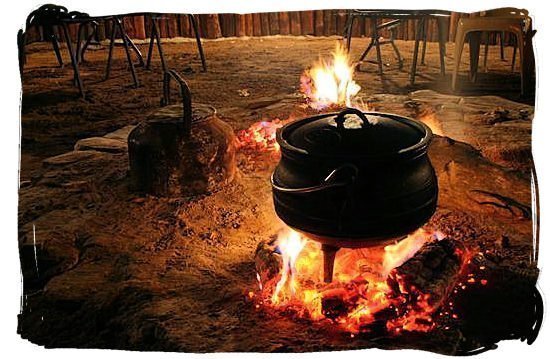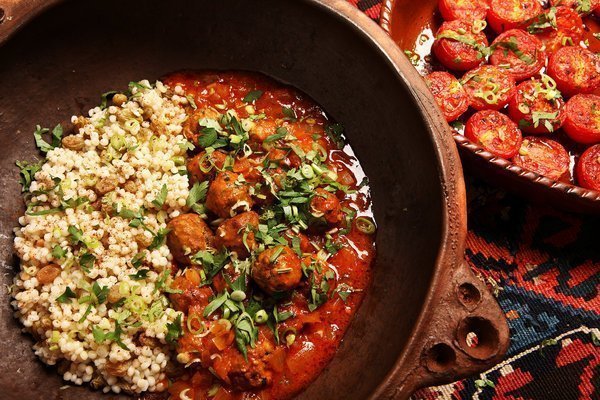What Is African Food Like?

Africa is a vast continent with rich cultural diversity. As such it has a rich and diverse cuisine.
With almost 5,000 ethnic groups, each with its own unique cuisine, it is hard to come up with what we can call “African food.” However, there are certain dishes that are common across multi-ethnic groups existing in various regions.
We are going to consider not just the dishes but also the cultural and environmental aspects that go with it, which all make up Africa’s fine dining.
We're also going to look at the traditional setup rather than the modern setup which has undergone a lot of exotic influence.
Atmosphere of African food
Some aspects of eating in Africa transcend the food itself. So, let's dive right into Africa's fine-dining scene!
Ambiance

When we look at the ambiance, we are considering the kind of environmental setup that prevails during dinner time in most places in Africa. The following are some of the common features by which ambiance makes a fine dinner in Africa:
- Night time – in Africa, dinner is held during the early hours of the night. This is between 7 pm and 9 pm
-
By the fireside – in most parts of interior Africa, dinner is held by the fireside. The fire serves several purposes
- source of light
- a source of warmth
- a source of deterrence against wild animals and insects (especially mosquitoes)
- a central point for gathering
- a cultural symbol of unity, among others.
- Moonlighting – during periods of the full moon, roast foods on an open fire are the most preferred way of eating while being socially engaged.
Togetherness

Food in Africa is not just a meal but a social gathering. Food is used as a means of strengthening bonds. As such, eating food alone is considered bad manners. The following are some of the ways by which togetherness makes a fine dinner in Africa:
- Warm family embraces – a fine dinner in Africa is one where the entire family comes together to share a meal.
- Stories – unlike in other cultures where people have to stay quiet while eating, in most African cultures, a fine dinner is a one which is escorted by sweet stories.
- Sharing dishes – togetherness extends to sharing dishes such as plates, beer pots, etc.
- Visitors – a fine dinner in Africa is one where there is at least a guest who is receiving some good treatment during dinner time.
Divinity
A fine dinner in Africa is one where divine intervention is sought and appreciated. It is not just about sharing meals with the living but also with ancestors and spirits. The following divine activities make a fine dinner in Africa:
- Prayers – prayers were always conducted before any given meal, more so dinner. Included in the prayers are thanksgivings to those who made the food, to God for the life that lives, and to the spirits and ancestors for protection. They are also prayers of blessing to the family and those who are partaking the meal.
- Sacred songs after eating – after eating, sacred songs are common.
- Leaving something for the ancestors – in most traditional African societies, not all food cooked is eaten. Some is left for the ancestors. This could be taken to special shrines e.g. a sacred tree, or simply be left for the wild animals.
Natural Diet
African traditional cuisine is natural. Although, it is now becoming increasingly rare to find a pure natural diet as modernity means more natural sources of food are becoming extinct. The following are some of what comprises a fine dinner of natural diet in Africa:- Clean eating – this refers to eating food as close to its natural form as possible.
- Balanced diet – Africa has a rich variety of green leafy vegetables that grow naturally. Apart from that, there are plenty of natural grains, cereals, and wild nuts. Game meat, livestock meat and other sources of proteins are also in plenty. However, urbanization means that these are a preserve of the remaining few indigenous rural communities.
- Natural recipes – recipes are often natural. For example, cooking oil/fat is extracted naturally from coconut, olive, palm, animal fat, etc. sugar is extracted naturally from honey, fruits, and nectar. Salt is obtained naturally from lakes and oceans. Those far from salty lakes use salt alternatives in form of savory herbs.
Special Ingredients
There are certain special ingredients that make fine dinner in Africa. These include:- Herbs – in traditional African societies, the boundary between food and herbs is blurred. This is especially the case when it comes to vegetables. Most vegetables also doubled up as herbs. Other than vegetables, there are pure herbs that are used to make food tender, break down lipids, ease up digestion, prevent stomach upsets, etc.
- Sour milk – taking a gourd of sour milk after the main dinner meal is a common practice in pastoralist societies.
- Spring water – in rural communities, the main source of drinking water is spring water. There is still a very low level of industrial pollution in African rural areas. As such, water is largely in its pure natural form.
- A hot cup of Chai – Chai, is a name given to tea. Traditionally, tea is taken after the main meal. This is common with the East African communities where tea has been grown for ages or imported from China and India prior to colonization. Chai also refers to any hot beverage comprising of boiled water, some herbs in it, and sweetener.
- Beer – beer in the evenings after meals is a common phenomenon in traditional African societies. However, this is only a preserve of elderly men. Children, youths, and women are generally barred from having a beer.
So, what's food in Africa like?
Africa is vast. Thus, the best way to look at African cuisine is on a regional basis. In most regions, there is a base meal.
A base meal is that meal which can be served with many other dishes as accompaniments. It can also be a base ingredient for those other dishes.
West African Dinner Cuisine

The following are the most popular dishes of the West African cuisine:
Base meals:
- Rice – mostly white rice of basmati variety.
- Fufu – a paste made from sweet starchy root vegetables. Cassava and Yams are popular ingredients.
- Rice: Jollof (West African), Thiebou Djeun (Senegalese), Waakye (Ghanaian), Ofada (Nigerian)
- Fufu (Nigerian): meat stew, fish stew, green vegetables, West African rice dish varieties (jollof, ofada, waakye, etc), palm nut soup, efo, egusi.
- Alloco (Ivorian) – fried plantain snack often served with eggs and seasoned with onions, spices, and tomatoes.
East African Dinner Cuisine

The following are the most popular dishes of the East African cuisine: Base meals:
- Ugali – this simply refers to stiffened porridge. It is commonly consumed in most parts of Sub-Saharan Africa, but predominantly in East, Central and Southern Africa. In Central Africa, it is called Nshima.
- Chapati – this is unleavened flat bred with a disk-like shape that is often baked on the open frying pan with just slight smearing of oil to avoid sticking on the pan and to give in golden-brownish coloration.
- Matoke – this simply refers to cooked (mostly steamed) green bananas. There is a special variety of banana (plantain) that is used for matoke. It is commonly consumed in Uganda, Rwanda, Burundi, and Western parts of Kenya.
- Nyama choma – this is simply smoked and barbecued meat.
- Injera – round, flat, stiffened, and thin disc-like dish made from fermented teff flour. It is often lightly baked to achieve the stiffened form.
- Pilau – heavily spiced pishori rice. Spices include coriander, turmeric, ginger, cloves, pepper, etc. Coconut milk is also used instead of water. Shredded coconut is also added to it. This is commonly served in the coastal areas of Somalia, Kenya, Tanzania, Zanzibar, and Mozambique.
- Ugali: fried vegetables, meat stew, sour milk, fish stew, fried green grams/beans, etc
- Nyama Choma: Kachumbari, ugali
- Injera: beyenatu, kitfo, Doro Wat
- Chapati: meat stew, ndengu, fried vegetables, etc
- Pilau: meat stew, ndengu, fried vegetables, etc
- Matoke: meat stew, green vegetables, grain stew (green grams, beans, peas, etc).
Central African Dinner Cuisine

The following are the most popular dishes of the Central African cuisine:
- Nshima – Central African name for Ugali (stiffened porridge)
- Pondu (mainly DRC) – a stew made from cassava leaves, palm oil, onions, and chili.
- Nshima: fried vegetables, meat stew, sour milk, fish stew, fried green grams/beans, etc
- Pondu: Nshima, meat, grains, etc
South African Dinner Cuisine

The following are the most popular dishes of South African cuisine:
- Bobotie (South African) – a mixture of minced meat and fruits with a creamy topping.
- Biltong (South African) – dried and cured meat. Common meat sources include beef, ostrich meat, game meat.
- Biltong: green vegetables, grain stew (green grams, beans, peas, etc)
- Bobotie: often eaten alone. Can be accompanied by green vegetables, fried grains (green grams, beans, peas, etc).
North African Dinner Cuisine

The following are the most popular dishes of the North African cuisine:
- Cholent – a slow-cooked mixture of beans, barley, potatoes, and meat. Rice can substitute barley while chicken can substitute meat.
- Brik – triangular-shaped pastry stuffed with whole egg, onions, harissa, parsley, and tuna fish. Some other varieties can include cheese, chopped boiled eggs, chicken, and ground meat.
- Couscous (Algeria/Maghreb region) – comprises of steamed small balls of semolina flour.
- Cholent: It is a full meal. You can take with your preferred smoothie or fruit juice
- Brik: you can take it with tea, a variety of stews, fruit juice, among others
- Couscous: You can take it with a variety of stews, grains (especially chickpeas), nuts (especially cashew nuts and pine nuts), soups, pomegranate, roast chicken, salads, etc.
Time to eat!
Fine dining in Africa simply means being vast and diverse in your cuisine, as the continent itself. Each part of the continent brings its own delicious uniqueness untasted anywhere else.
This is what makes Africa unique. A visit across Africa is a way to make your tummy experience an unprecedented variety.

